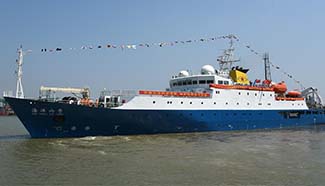MEXICO CITY, July 98 (Xinhua) -- The 3rd Olympic Games, held in St. Louis, United States in 1904, unfortunately repeated all the same errors of the previous 1900 Games. Once again the international sporting event coincided with the World's Fair taking place in the same city and there were few noteworthy performances. There was also limited participation from international athletes.
Taking place between July 1 and November 23, 651 athletes (six women and 645 men) from 12 countries and regions participated in the Olympics held in the U.S. city of St. Louis, competing in 95 events.
The Games were incorporated into the St. Louis World's Fair (1904) and for that reason the organizers spread the various competitions out over four-and-a-half months.
Despite massive investment, the hosts had little success in attracting European athletes to the competition. Under 100 athletes came from outside of the United States and Canada.
The tradition of handing over gold, silver and bronze medals to the top three athletes in each sporting event began at the Games of the III Olympiad, as it is officially known.
Four new additions were also made to the competition schedule - boxing, freestyle wrestling, decathlon and a dumbbells event.
Basketball, hurling and baseball were included in the St. Louis Games but only as demonstration sports.
U.S. athlete Archie Hahn, known as the "Milwaukee Meteor," won the 60, 100 and 200 meters on track and he set a new Olympic record in the final category with a time of 21.6 seconds. This record remained unbeaten for 28 years.
In the discus, Martin Sheridan and Ralph Rose, both from the United States, drew in the final as they both threw a distance of 39.28 meters. To decide the winner, the judges decided to give them both one more throw. Sheridan won the decider and the gold medal.
In gymnastics, the most remarkable athlete was Anton Heida from the U.S. who won five gold medals in the pommel horse, horizontal bar, long jump, vault, combined and team competition titles. He also came second in the parallel bars.
In the same sport, fellow U.S. gymnast George Eyser won six medals in one day - three gold medals in the team competition, parallel bars and rope climbing and two silver medals in vault and pommel horse and a bronze medal in the horizontal bar. Eyser achieved all this despite having a wooden prosthesis for a left leg.
Until 2008, Eyser was the only person with an artificial leg to have competed at the Olympic Games. In 2008, Natalie du Toit, a South African swimmer who lost her left leg in a traffic accident, participated in the 10km swimming marathon in Beijing and finished 16th.
Moving on to fencing, Cuba's Ramon Fonst, who competed and won one gold medal in Paris 1900, won three gold medals and later on competed in the 1924 Games, once again in Paris.
The St. Louis Games were also the first ones to look into doping. The first case related to stimulant substances involved athlete Thomas Hicks, the marathon winner, who had received several doses of strychnine sulfate (a common rat poison, which stimulates the nervous system in small doses) from his trainers.
OLYMPIC GAMES ST. LOUIS 1904 MEDAL TABLE
COUNTRY GOLD SILVER BRONZE TOTAL
United States 78 82 79 239
Germany 4 4 5 13
Cuba 4 2 3 9
Canada 4 1 1 6
Hungary 2 1 1 4
United Kingdom 1 1 0 2
Mixed Groups 1 1 0 2
Greece 1 0 1 2
Switzerland 1 0 1 2
Austria 0 0 1 1










